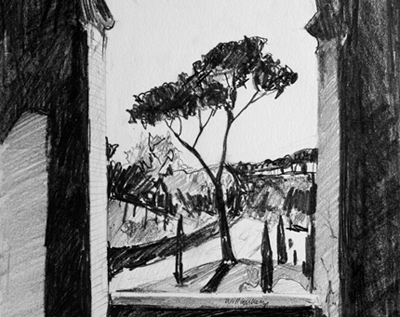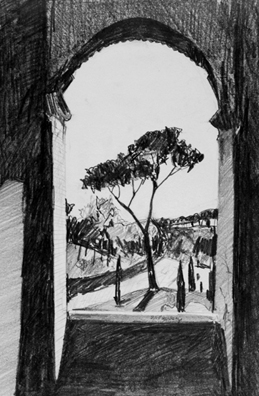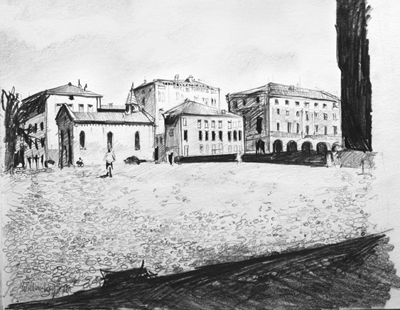
Drawings by Will Kemp
Ever wanted to learn to draw?
Have you daydreamed of just picking up a pencil and sketching?
But inside there is a lingering doubt.
A distant memory of a school teacher who told you once you were bad at art.
An inner critic that holds you back…. Even before you begin.
But what if you could learn to draw?
What if the principles of drawing could help you to become more productive in other areas of your life.
Would you give it a try?
Feel the fear, and draw it anyway.
Productivity is often linked to a fear of failure, an obsession with thinking rather than doing. Of reading one more book or enrolling on one more course until you are ‘ready’.
Learning to draw forces you to face your fears head on and takes you out of your comfort zone.
To draw something, anything, for the first time is scary.
You can feel very vulnerable when your work is out in the open for criticism especially before it is finished.
To get productive you have to push through these blocks, accept it is not going to be perfect and get to work.
A clear sign of procrastination is a blank page so put pencil to paper and the rewards can be fantastic.
To have the confidence to draw out your problems will help you solve them quicker, and to be able to record that view you admired so much on your holiday with a pencil rather than a camera will be priceless.
To be creative you actually have to do something. It involves putting your imagination to work to make something new, to come up with new solutions to problems, even to think of new problems or questions. You can think of creativity as applied imagination.
Ken Robinson, The Element: How Finding Your Passion Changes Everything
1. Embracing Mistakes

A drawing is never correct the first time. You always have to alter what you first thought was ‘correct’. Areas that you were convinced were perfect sometimes have to be completely repainted or scrapped.
Accepting that whatever you are working on won’t initially be perfect is key to making things happen. Mistakes or “failures” act as a lighthouse guiding a ship into dock. Every tweak adjusts the rudder, giving you a direction in the vast ocean of ideas, initially they will be big adjustments but as you get closer to your destination they will be smaller and smaller.
The trick is to realize that these are all signs of improvement and not to get disheartened.
2. Talent Is Overrated
Beginners often think you need a natural talent for drawing. You don’t.
Drawing is a skill that can be learnt.
Tiger Woods didn’t just pick up a Golf club, swing and hit a hole in one. He practiced and practiced. Don’t give up when your first drawings don’t resemble what you imagined, just see them as a visual diary of your progress.
We often have an in built ‘taste meter’ when we know we can do better, we know our work looks crap, we’re just not sure how to make it better!
This willingness to start something even when you know it won’t be 100% is crucial in becoming more productive.
3. Create More, with Less
To be able to draw a subject accurately you need to fully concentrate, and because of this intense focus, your eyes get tired.
You need to have regular breaks to be able to see the objects correctly. I usually find about 90 minutes is my optimum painting time.
We’re not designed to work for continuous lengths of time, it effects our ability to judge subtle differences and nuances. So work intensely, then make a brew and give your eyes a break.
You don’t get more productive by working more hours, but working intensely in short, focused bursts.
4. The Minimalist Productive
How many new ideas did you have this morning? And how many new articles did you feel you ‘had to read’ before getting started?
Being overwhelmed by the number of options is often worse than no ideas at all.
So tomorrow morning try drawing out your options rather than making a list. The drawings don’t have to be accurate, just a simple stickman will do, but by actually drawing out your issues it can be easier to visualise which direction makes sense.
It is a myth that multitasking makes you more productive. When you are drawing it forces you to focus on the now.
You can’t check email and draw at the same time. So apply these principles to other areas of your work that you try to juggle.
5. Sketch First, Paint Later
Drawing can be extremely effective in working through large scale ideas. And when you start drawing or painting you soon begin to appreciate how a little planning can make a big difference.
The Old masters always made sketches before embarking on a large scale painting. Sculptors make Maquettes (small scale versions of the finished piece) before starting to chisel the marble.
Painting and drawing takes time. And you don’t want to waste your time on a large scale piece if you haven’t tested a few options first.
So think about ideas you are working on and try to work out how you can make a ‘sketch’ of the project. Maybe a novel could be a short story, a jewellery collection could start with just rings. Start small, but think big.
6. A Little and Often
To keep on top of drawing you need to keep a regular schedule, even 5 minutes a day will keep you focused.
This could be on your journey to work, in a lunch break, or in a really boring meeting!
Momentum is key.
The more regularly you draw, the easier it will become.
When I first started my Youtube channel my aim was to post one new video per week. To start with this didn’t seem enough and I was itching to create more or publish more regularly but I forced myself to stick to the rules, one video a week, every week.
If I had decided to try to film one a day or every few days I would have definitely failed.
I’m now at 24 videos in 3 months and counting, this regular but small approach has helped to keep momentum and build the project – what’s more it’s become a habit.
7. Unlocking Your Creativity
Drawing is fantastic at engaging the right hand side of your brain, and if you’re having a creative block, drawing can help to kickstart your mind. To draw accurately you have to fully engage with your right hemisphere of the brain, the left hand side which is more logical and analytical will always try to ‘help’ out by trying to recall memories of objects for you.
It makes assumptions about what it ‘thinks’ is in front of you rather than what actually is there. Learning to draw is actually more about learning to see and discovering a new visual language.
Professor Betty Edward’s states in her book Drawing on the Artist Within:
You will also discover that this new language, when integrated with the language of verbal, analytic thought, may provide the ingredients essential not only for true creativity – that is, new or novel ideas, insights, inventions, or discoveries that have a social value – but also for useful creative solutions to the problems of everyday life.
So next time you find yourself trying to juggle too many things grab a pencil and paper and draw.
You may be surprised to discover the inner artist just waiting to be let out. And your new found productivity will give you the free time needed to indulge in your new creativity!
Over to you
Have you recently faced your fears and learnt a new skill that you’d being putting off for years?
Did you used to draw as a kid but have got out of the habit?
I’d love to hear your story.
About the Author Will Kemp can teach you how to draw. He is shortly starting a new online drawing course for absolute beginners.



Will, thank you for this guest post on Lateral Action. I cannot agree more with the points you have raised, and as a trained artist I appreciate your dedication to the craft.
You (and the readers of this post) may be interested in Danny Gregory’s story. He taught himself to draw in his 30s as a way to transform himself and cope with a personal tragedy. Since that time, he has written a number of books geared toward people who want to learn it simply for the love of drawing.
His first book on drawing, “Everyday Matters,” is a poignant story which would be very encouraging to someone who might have always wanted to draw, but felt afraid to try. Some of the advice you give above reminds me of what Danny had written.
Here is a link to his website: http://dannygregory.com/.
Thanks again for the great post.
Bob Fisher
Hey Bob,
Glad you enjoyed the post.
Thanks for the link to Danny’s site, I’ll have a look, it sounds like a really inspirational story.
Will
Hey Will,
I’ve just checked out your site. Awesome stuff. I’ll mention it on the sketchbob.com Facebook fan page.
Unfortunately, when I went to art school very few people could answer my questions about traditional painting techniques, and no one knew how to translate an academic approach into acrylics. Pity we didn’t have time-lapse videos like the ones you show; they would have been very helpful.
I’m looking forward to checking out your site in more depth. Thank you also for being so generous with your knowledge.
Bob
Hi Bob, thanks very much for your kind comments, pleased to hear you’be been enjoying the site,
Thanks again,
Will
Very helpful post.,Will, thank you very much.
When I am drawing I spend too much time correcting details.So, instead of spending just 10 mins for drawing something very simple, I spend an hour. That’s why I don’t draw as often as I would like to. But I must start doing 10 mins from now on.
Tania
Hi Tania, glad you enjoyed the post. Sometimes the thought of creating a drawing that will take an hour is enough to stop starting. Aim for 10 minutes and you might surprise yourself.
Will
Great article Will.
I agree that drawing is a fantastic way to engage you right brain. I’m also not that great at it but it is good to practice.
I took an online experimental art course once and one of the lessons was to copy picasso’s pencil portrait Igor Stravinsky. We had to print out a copy of the portrait and copy it within a time limit of 15 minutes.
The challenge was then to turn the print upside down and again copy it within the 15 minute time limit. It was a very bizarre experience actually and very interesting to compare the two completed drawings. Amazingly, they were both totally different. Everyone in the class had the same experience!
It’s a great exercise to do before you start working on any creative endeavour!
Hi Alison,
Glad to hear you liked the article.
I’ve used a similar technique with my students in the past and it really can be eyeopening.
Thanks again,
Will
Will,
I completely agree with you. Drawing can be a way to unlock your creativity when you are blocked.
Reading your article reminds me of creating music. Sometimes when I am completely blocked as to how to start singing, I simply listen to other pieces of music and then after a while I come back to it filled with ideas as to how to start.
My advice: whenever you are blocked drop whatever it is that you are doing and look at other people’s work, looking for patterns. By the time you are through with that you will have plenty of ideas to work with.
Yours Truly
Sam Lab
Hey Sam,
Really interesting to hear it from a musicians perspective.
I find having regular breaks really helps – or maybe I love tea too much!
Thanks
Will
I very badly want to learn to draw, but I am 31 years old, and have the approximate skill level of a one year old. I don’t know any techniques, and I have a paralyzing fear of doing anything precisely BECAUSE it will look worse than a one year old’s output.
I can’t do this if I’m not enjoying this, and I can’t enjoy this if I’m being mocked, and constantly failing.
I thought buying a book aimed at teaching young children to draw would help, but even that demands a pre-test before any instruction, and I just don’t know how to go and do the pre-test in a way that proves that I am taking it seriously, and not just half-assing it to get past it…
Hi Hikaru, this comment really made me smile this morning!
Age is no boundary to learning to draw so being 31 will be just fine.
I can appreciate how overwhelming it can be, even with a young children’s drawing book as guidance, because the physical act of putting pencil to paper is still just as hard.
Having zero techniques is actually a good thing, because it is the least important thing you need to know when learning to draw.
The real trick is learning how to see and that doesn’t even involve a pencil, just a mental shift.
I’d love to see you on the drawing course as it sounds like you could have a real creative breakthrough on the course. And would set me a great challenge!
If you have any further questions just drop me an email,
Will
Very helpfull, last year I realized that I wanted to learn how to draw, as an innovator amd a problem solver, it is mandatory to know how to draw and design the things you have in mind. They might mot be perfect, but they will give accurate idea of you’re innovation design. Try Google Sketchup, it’s great.
Hey Javier,
Glad you liked the post, you’ve got a great point about the drawings not having to be perfect, but as a fantastic tool to open your eyes to new possibilities you might not have thought of beforehand.
Will
Thank you so much for the post. It is very interesting and insightful. It not only reflects the ins and outs of creative thinking, but is a good “welcome” to all interested in viewing the world differently. Again, THANK you!
Hi Juan,
Thanks for your kind comment, pleased to hear that you enjoyed the post. Learning to draw really can help you to see things differently and approach things from a different angle.
Thanks again,
Will
Great post! I have just recently gotten back into the habit of drawing and it’s true, it really does help you think. I used to draw all the time but then life got too busy. Recently, I’ve been making time for it and it has really helped my productivity in a lot of areas. It’s great to exercise that right brain!
Will, where can I read more blog posts by you?
Hi Mark,
Glad you enjoyed the post. Great to hear you are finding time for your drawing.
You can find more of my posts at http://www.willkempartschool.com
Thanks,
Will
I just signed in today to drawing lessons, and I was so scared, I am horribly shy and even stuttered when the teacher was giving me the tour of the place.
I am happy I ran into the post, in my case the goal is much greater than the fear, so let’s see what happens.
this article was good…..
Great article with very effecive inspirational message. Thank you!
I have tried to learn how to draw and discovered something I think is weird. Not only can I not draw but it looks like I`m not able to learn it. 🙂 And I`m not kidding at all, I like to paint abstract things and always wanted to learn how to draw good pictures of things like landscapes and trees and furniture. But my mind wont allow me to put something in 2D on a paper, there`s just no way, it`s impossible for me to draw depth and perspective, I actually end up lifting the pen off the paper, drawing in the air, and I always end up drawing as if I saw it from above. I think it`s becasue I look down at the paper. It`s interesting in a way, I see other people draw the most amazing things like it`s really easy and I have really tried many times but no, and it`s not like I at least have gotten a tiny bit better, I suck just as much now as I did before I started trying, I see or feel no improvement on anything, at all. Starting to think I`m actually not able to learn this, I have some sort of mental block. Does that happen? 🙂
I’m goine to colnvey my little brother, thuat he should also pay
a visit this webzite on regular basis to get updated from newest
information.